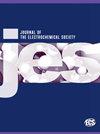全耦合电-热-流建模及铝电解槽动态热边缘行为研究
IF 3.3
4区 工程技术
Q2 ELECTROCHEMISTRY
引用次数: 0
摘要
铝电解槽(AEC)需要有效的热调节,才能与可再生能源一起灵活运行。在实施热调节策略之前,有必要预测全尺寸电池的热场和壁架特性的动态变化。本研究为全尺寸 AEC 引入了一个瞬态电-热-流耦合模型,旨在研究壁架分布与各种运行场(包括热场、电场和流场)之间的相互作用。该模型有助于计算和评估±15%柔性电流变化下窗台的动态特性和热平衡。结果表明,在电流增大时,壁架熔化主要发生在电解质层,而在电流减小时,壁架凝固主要发生在金属层。壁架较厚、速度较快的区域往往在电流增加时熔化得更多,而在电流减小时则不太可能恢复到原来的形状和厚度,从而使快速恢复热平衡变得更加复杂。为了实现均匀的壁架分布并实时适应灵活的电流变化,建议在 AEC 的两侧安装分布式冷却装置,以实现不同位置的不同壁架调节。本文章由计算机程序翻译,如有差异,请以英文原文为准。
Fully-Coupled Electric-Thermal-Flow Modeling and Investigation of Dynamic Thermal-Ledge Behavior in Aluminum Electrolysis Cell
Aluminum electrolysis cells (AECs) require effective thermal regulation to operate flexibly alongside renewable energy sources. Prior to implementing thermal regulation strategies, it is essential to predict the dynamic variations in the thermal field and ledge characteristics of a full-scale cell. This study introduces a transient electro-thermal-flow coupling model for a full-scale AEC, aimed at investigating the interactions between ledge distribution and various operational fields, including thermal, electric, and flow fields. The model facilitates the calculation and assessment of the dynamic properties of the ledge and thermal balance under ±15% flexible current variations. Results indicate that during a current increase, ledge melting predominantly occurs in the electrolyte layer, while ledge solidification is primarily observed in the metal layer during a current reduction. Regions with a thicker ledge and faster velocity tend to melt more during current increases and are less likely to return to their original shape and thickness during current reductions, complicating the rapid restoration of thermal equilibrium. To achieve uniform ledge distribution and real-time adaptation to flexible current variations, it is recommended to install distributed cooling devices on the sides of the AEC to enable differential ledge regulation at various locations.
求助全文
通过发布文献求助,成功后即可免费获取论文全文。
去求助
来源期刊
CiteScore
7.20
自引率
12.80%
发文量
1369
审稿时长
1.5 months
期刊介绍:
The Journal of The Electrochemical Society (JES) is the leader in the field of solid-state and electrochemical science and technology. This peer-reviewed journal publishes an average of 450 pages of 70 articles each month. Articles are posted online, with a monthly paper edition following electronic publication. The ECS membership benefits package includes access to the electronic edition of this journal.

 求助内容:
求助内容: 应助结果提醒方式:
应助结果提醒方式:


